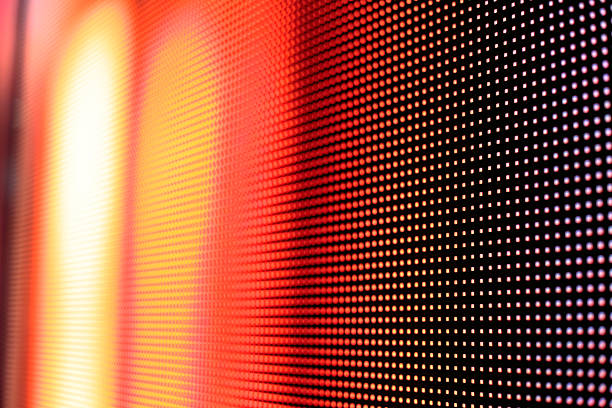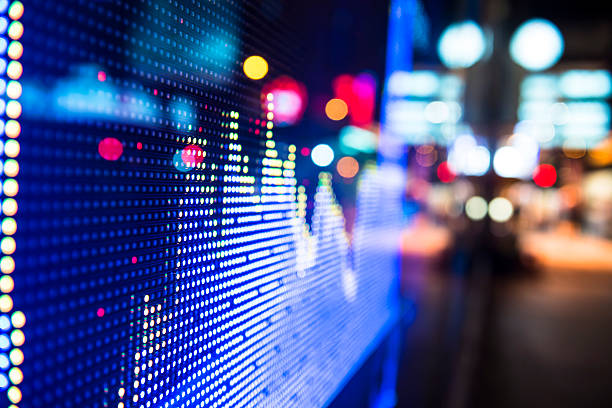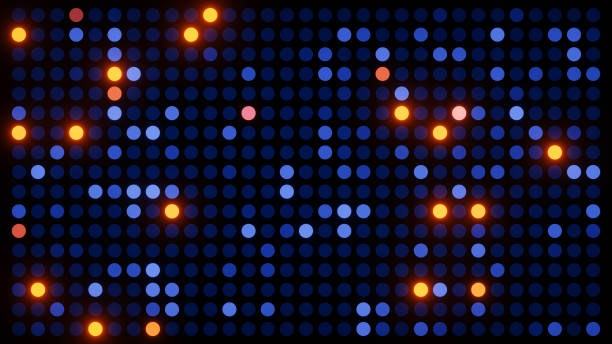What Are the LED Displays?
1. Brief introduction
As we all know, international football events like the 2022 Qatar World Cup attract millions of people to watch the game.
The security system inside and outside the stadium requires a large number of display screens. The small LED pitch and its high-definition display screen can definitely meet the security requirements of Qatar. As long as you can seize this opportunity, you can easily enter the local security market.
Of course, there are other event information screens, digital advertising screens, spherical screens, creative screens, etc., which will be a big gap, providing a huge application market for many domestic screen companies!

2. What is LED display
LED display, also known as electronic display, is composed of LED dot matrix. Text, pictures, animations and videos can be displayed with red or green lights. Content can be changed at any time.
All components of the LED display are modular display devices.
LED display is usually composed of display module, control system and power supply system. The display module is composed of LED dot matrix, which is responsible for light-emitting display; the control system controls the lighting in the corresponding area to display text, pictures, videos, etc. on the screen; the power supply is responsible for converting the input voltage and current into the voltage and current required by the display screen .
LED displays can display changing numbers, texts, graphics and images, and can be used not only in indoor environments, but also in outdoor environments, with incomparable advantages for projectors, video walls and LCDs.
The reason why LED has been widely valued and developed rapidly is inseparable from its own advantages.
These advantages can be summarized as: high brightness, low operating voltage, low power consumption, miniaturization, long life, shock resistance, and stable performance.
3. Classification of LED display
According to the application place, it is mainly divided into two types: indoor and outdoor:
(1) Indoor screen
The indoor screen is mainly used indoors. In the production process, the light-emitting lattice module is first made, and then the modules are spliced into a certain size display unit board.
According to user requirements, the display unit board is used as the basic unit, and it is spliced into the size required by the user.
(2) Outdoor screen
Outdoor screens are mainly used outdoors. In the production process, the luminescent particles are first packaged into a single LED, which is called a single lamp.
Single lights used to make outdoor screens generally use a reflector with focusing function to improve brightness, and then package multiple single LED lights into a single pixel tube or pixel module, and the pixel tube or pixel module forms points according to user needs and display applications. Array display unit box field, use a display unit box as the basic unit to form the required size.
The box body of the outdoor screen should be sealed to achieve the purpose of waterproof and anti-fog, so as to adapt to the outdoor environment.
According to the primary color, it is mainly divided into three types: single primary color, double primary color and full color:
(3) Single primary color
A single primary color has only one color per pixel, most of which is red.
Because red has high luminous efficiency, it can achieve higher brightness.
It can also be green or a mixed color, i.e. part red, part green and part yellow.
(4) Dual primary colors
Each pixel of a dual primary color has two primary colors: red and green, which can be superimposed on yellow.
In the case of grayscale control, a maximum of 65535 colors can be combined by changing the different grayscale levels of red and green.
(5) Full color
Full color is also known as three primary colors, and each pixel has three primary colors of red, green, and blue.
Under the condition of grayscale control, through the change of different grayscale levels of red, green and blue, the natural color can be restored well, and 16777216 colors can be combined.
According to the function, it can be divided into four types: strip screen, graphic screen, video screen and digital screen:
(6) Strip screen
This display is mainly used to display text.
It has its own 16×16 or 24×24 bitmap font library and can work independently.
It can use the remote control to input Chinese characters, or it can be connected to the computer to send information through the computer, so that you can work offline.
Because most of these screens are made into bar counters, they are called bar counter screens.
(7) Graphic screen
This kind of display screen is mainly used to display text and graphics, generally there is no grayscale control. It enters information by communicating with a computer.
Graphics screens have the advantage of rich fonts and graphics compared to bar screens.
Compared with video screens, the biggest advantage of graphic screens is that one computer can control multiple screens and display them offline.
(8) Video screen
The pixels of the display screen and the monitoring pixels of the control computer have a one-to-one mapping relationship, and have grayscale control, so their expressiveness is extremely rich, and the video screen can also play video signals when equipped with a multimedia card.
The video screen has good openness and can reflect the display of the computer monitor in real time.
(9) Digital screen
Digital screen is the cheapest LED display, widely used in bank exchange rate, interest rate display, hotel seafood price list, room price list, etc.
In most cases, a strip screen is installed on the digital screen to make up for the deficiency that the digital screen cannot display text.
(10) Hybrid screen
That is, dot matrix digital mixed display, it is most used for stock market display.

4. Technical advantages
(1) Equipped with a full-color display screen and the introduction of higher-quality imported LED chips, which makes the screen image high-definition, uniform in color, low power consumption, lightweight, thin screen layer, and wide-area viewing angle, so it fails. Small probability, easy maintenance.
(2) It mainly adopts a multi-function multimedia display card PCTV card, which has more excellent performance, more advanced acquisition methods, can accurately capture video, and has Studio editing software that matches the display card.
(3) DVI interface technology is more advanced. There is no need for A/D and D/A conversion, which ensures the integrity of the picture image, reduces the possibility of details, and completely reproduces the computer image on the display screen. DVI can support all display modes, ensure the stable and reliable data display and also have a variety of integrated functions.
(4) Use the indoor full-color system to alleviate the hidden dangers of the system displaying and transmitting a large amount of complex data, and fully perform full-color restoration. Use the chip to complete the task of data distribution and display, convert the received data to pulse output, convert from 8-bit (8-bit) display data to 12-bit PWM, and upgrade it to 4096 (12-bit) level grayscale control to realize non-linear 256-level visual display on the screen Grayscale, fully create full-color visual enjoyment.
(5) The drive mode adopts constant current system. Through its high cost performance, it can improve the lack of discrete voltage drop in LED tubes, overcome the mosaic problem, and ensure the quality of the picture.
(6) Combined with the mode of optical fiber transmission, the loss of the signal during transmission is reduced.
5. Performance
(1) Color, brightness and viewing angle
With the combination of diodes and semiconductors, its production materials and manufacturing processes are gradually upgraded, breaking through the limitations of the original brightness and color, and a large number of blue diodes and pure green light-emitting diodes are used to improve the display brightness.
This further enhances the advantages of LED display screens in outdoor environments, adapts to different display requirements, and enhances the effective value of LEDs in different environments.
The evaluation of LED display performance must be the result of comprehensive consideration, because related performance indicators are closely related, and indicators such as brightness, viewing angle, and resolution affect each other.
Currently, surface-mount LED devices are used in high-density, full-color indoor displays to improve the viewing angle and brightness performance of the display.
(2) Gray scale
The gray level of the LED display is mainly used to evaluate its color reality. By judging the brightness level between the darkest single primary color and the brightest, the display color is evaluated based on the gray level.
When the gray level is high, the display is rich and colorful; when the gray level is low, the color change is single.
Therefore, the improvement of the gray level is beneficial to increase the color display level of the image and help to improve the color depth.
(3) Contrast
The contrast of the display screen affects the visual imaging effect. High contrast can improve the clarity and bright colors of the picture, and effectively improve the detail texture, clarity and gray level of the image quality.
In addition, the contrast also has a certain influence on the resolution and conversion of dynamic videos. High contrast can make it easier for the naked eye to distinguish the light-dark conversion process in dynamic images.
(4) Refresh frequency
The number of times the content of the LED display can be repeatedly displayed per second is called the refresh rate. When the refresh rate is low, there will be image flickering, especially in the process of video shooting. The flickering is too obvious, so it must be maximized. Increase the refresh rate to ensure the stability of the display screen.
6.Application
With the development of the LED display industry, the varieties and specifications of the display screen are constantly diversified and intelligent, the application field is constantly expanding, and the visibility in the daily field is getting higher and higher.
As a new generation of display media, it has already entered the mainstream display market, and has become an indispensable display window in the field of image promotion of enterprises and institutions and information display in public places.
In almost all social service fields such as stations, airports, schools, hospitals, securities, shopping malls, gymnasiums, stages, dispatching, etc., LED displays can be seen everywhere.




